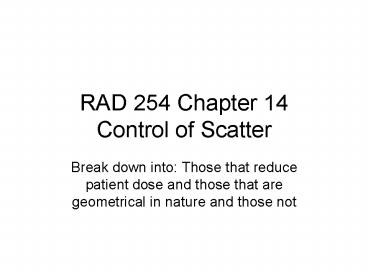RAD 254 Chapter 14 Control of Scatter - PowerPoint PPT Presentation
1 / 17
Title:
RAD 254 Chapter 14 Control of Scatter
Description:
Grid ratio = height of the lead lines divided by the interspace WIDTH ... Grid weight refers to how heavy it is duh the more lead, the heavier it is. Grid Types ... – PowerPoint PPT presentation
Number of Views:509
Avg rating:5.0/5.0
Title: RAD 254 Chapter 14 Control of Scatter
1
RAD 254 Chapter 14Control of Scatter
- Break down into Those that reduce patient dose
and those that are geometrical in nature and
those not
2
3 factors affecting scatter (primary)
- Increased kVp
- Increased field size
- Increased patient thickness
3
Spatial Resolution Contrast Resolution
- Spatial resolution may be thought of as geometric
in nature (focal spot size, emission spectrum,
etc. dealing with geometric image formation - Contrast resolution driven by scatter and other
sources of noise
4
Scatter
- Increased field sizes more scatter
collimation is the most readily available and
easiest thing to lower the amount of scatter - Patient thickness also increases scatter
compression may be used to help avoid this (IVPs
and mammo are examples)
5
Beam restricting deviceslimit the radiation to
the patient
- Aperature diaphram (size and resultant field size
are a direct proportion draw the damn picture
and figure the problems) - Cones and cylinders great for absorbing
scatter, but are circular shaped great for
improving contrast and removing scatter BUT
requires much more mAs as a result
6
Variable aperture diaphram
- Mandated in 1974 by the US Dept of Food and Drug
Administration (mandate removed later) - Positive Beam Limitation Devices (PBLs)
- Automatically collimate to the size of
cassette/receptor in the bucky and CANNOT be a
bigger size than the film/receptor
7
Filtration
- Filtration also will decrease the low energy rays
and limit patient dose and some scatter
8
The GRID
- Only FORWARD scatter is of any benefit to the
radiographic image all other scatter degrades
the image!
9
Scatter LOWER contrast
- Using a grid (alternating strips of fine leaded
strips with alternating radiolucent interspace
material) can effectively reduce the amount of
ANGELED scatter from reaching the film/recepter
10
Grid terms
- Grid ratio height of the lead lines divided by
the interspace WIDTH - Grid frequency/lines per inch the more lines
per inch, the more clean up - Grid clean up scatter w/o a grid vs scatter
reaching film with a grid AKA Contrast
Improvement Factor - Grid function improve image contrast
11
Bucky Factor
- Refers to the AMOUNT of radiation to the patient
with a grid vs W/O a grid. - Higher the grid ratio the higher the bucky
factor - The higher the kVp, the higher the bucky factor
- Grid weight refers to how heavy it is duh the
more lead, the heavier it is
12
Grid Types
- Parallel
- Crossed (cross-hatch)
- Focused
- Focused - crossed
13
Grid Problems
- Grid cut-off short SIDs result in the
vertical, parallel strips absorbing the
diverging beam at the outer margins of the
grid/film/rescepter MOST pronounced at short
SIDs - Most grid problems are positioning related
- Uneven grid/off level grid
- Off centered (lateral decentering)
- Off focus grid
- Upside down focused grid
14
Focused Grid Misalignment
- Off level grid cutoff across image
underexposed image (light) - Off center ditto
- Off focus CR centered to one side or the other
of a focused grid - Upside down grid severe grid cut-off (no
density) at both sides of the image
15
Grid Ratio Selection
- 81 grid is the most widely used
- Grid ratio is kVp driven
- Higher kVps warrant higher grid ratios
- Higher grid ratios higher patient dose (more
radiation needed to produce an image) - As kVp increases past MAXIMUM OPTIMUM kVp,
patient dose INCREASES
16
mAs Grid considerationsAs grid ratio
increases, so much mAs
- 51 grid 2 X mAs
- 81 grid 4 X mAs
- 121 grid 5 X mAs
- 161 grid 6 X mAs
17
Air gap technique
- By allowing the scatter radiation to diffuse in
the atmosphere after the patient but BEFORE the
film results in a higher contrast image as the
scatter diffuses and does NOT reach the film - C-spine lateral is a good example of this































